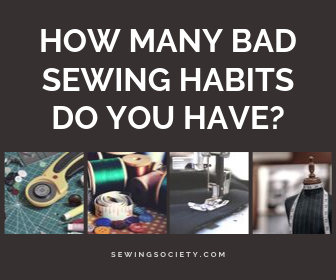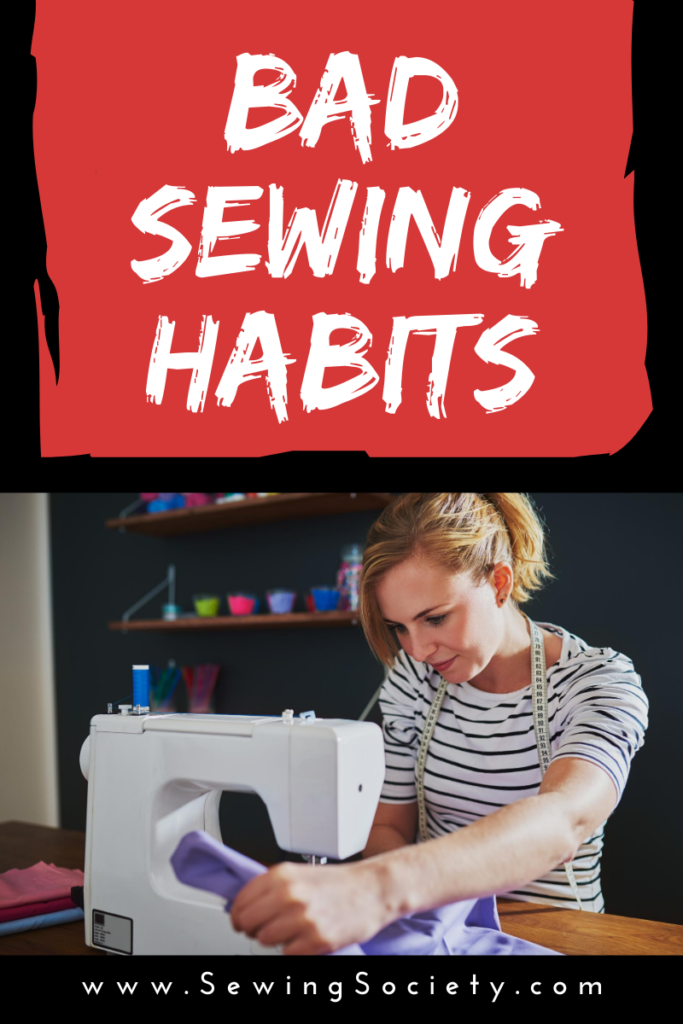Disclosure: This post may contain affiliate links. I earn a small commission when you click a link and make a purchase. Thanks for supporting SewingSociety.com!
If you’ve been sewing for a while, I bet you’ve developed some bad habits. I know I have! Here’s a list of 15 bad sewing habits that you need to break.
I want to know how many bad sewing habits you’ve developed. There’s a poll at the end!
Contents
1. Putting Pins in Your Mouth
Do you put pins in your mouth after removing them from your sewing project? That’s a bad habit that could make you end up in the hospital. People have swallowed pins and needed surgery to remove them. Pins can do serious damage to your esophagus and stomach. Never put pins in your mouth because you could accidentally swallow one. Instead, wear a pincushion on your wrist so you’re not tempted to put pins in your mouth.
2. Cutting Paper with Your Sewing Scissors
Have you ever used your sewing scissors to cut something other than fabric? That’s a bad habit because paper, plastic, and other materials will dull the blade of your scissors and you’ll have a more difficult time cutting out fabric. Yes, you can get them sharpened, but it would be annoying to pay for that all the time. Most people are extremely protective of their sewing scissors. You should be, too!
3. Not Marking Notches and Darts
Do you skip the step of marking notches and darts when cutting out your sewing projects? That’s a bad sewing habit because it’s harder to line pattern pieces up if you don’t make the markings. Your sewing project might not turn out perfectly aligned if you’re just guessing. It only takes a few extra seconds to mark your fabric with a fabric pen. Of course, I still rely on the tried and true method of tailor tacks.
4. Not Pinning Before You Sew
Do you skip pinning altogether or only use the bare minimum needed to hold your pieces together? That’s a bad sewing habit because your seams won’t look as straight as they should. Pinning takes extra time, so it’s not surprising that people often skip it. Yes, you can probably get away with not pinning if you have a long, straight seam to create, but not pinning around corners is a big mistake. You don’t have to put a pin in every inch, but you should pin all corners and use more pins on all curves.
5. Only Measuring Your Model Once
Do you only measure your model once, even when you’re working on the same sewing project for more than a month? That’s a bad sewing habit because if you don’t finish your sewing project in one sitting, your model may lose weight or grow taller. Your finished sewing project won’t look good or fit right. Kids grow and people fluctuate in weight, sometimes significantly. Always measure your model again when you’re close to finishing your project so you can make the proper alterations without extra steps or unpicking thread.
6. Cutting in the Same Spot on Your Self-Healing Mat
When you’re cutting out quilt squares or other repetitive cutting tasks with a rotary cutter, do you always cut in the same spot on your self-healing mat? That’s a bad sewing habit because even though your mat is “self-healing,” it can’t take too much stress in one area. I love using a rotary cutter and self-healing mat because it speeds up cutting, but if you repeatedly cut in the same spot, it shortens the life of your mat.
7. Never Changing Your Needle
Do you leave the same needle in your sewing machine for months? That’s a bad sewing habit because it becomes dull and bent as you sew. This can lead to uneven stitches, broken thread, and a host of other sewing machine problems.
Sewing machine manufacturers recommend that you insert a new needle at the start of every project. When was the last time you changed your needle? If you can’t remember, then it’s time for you to insert a new one. Replacement sewing machine needles are inexpensive if you buy them in bulk.
8. Hunching While You Cut and Sew
Do you have bad posture while sitting at your sewing machine or when leaning over your table to cut out fabric? That’s a bad sewing habit because it will hurt your back and make you feel fatigued faster. Pay attention to your posture so you can sew longer.
Getting a sewing table with an airlift is a great way to fight back fatigue. You can lower your sewing machine so that the needle plate lines up with the height of your table.
9. Buying New Fabric Before Checking Your Stash
Do you go to the fabric store and buy tons of new fabric and notions before checking your stash first? That’s a bad habit because all that fabric will sit in your closet unused. Not only is that a waste of storage, but it’s also a waste of money.
I know I have a difficult time resisting the urge to buy cute fabric when I see it. Sometimes it’s my guilty pleasure. My husband used to say he didn’t want to see me come home with new fabric until I had used everything I already had, but he gave up on that years ago.
10. Never Taking Your Sewing Machine in for Maintenance
Has your sewing machine been sitting in your sewing room without being serviced for more than five years? That’s a bad sewing habit because sewing machines need to have their hook timing reset and their internal compartment cleaned out regularly to last longer. Sewing machine manufacturers recommend that you take your sewing machine in for a tune-up every one to two years. You may need to take it in more frequently if you do a lot of sewing or you develop a problem.
If you can’t remember the last time you took your sewing machine in for service, it’s time for you to make an appointment with a repair technician. Regular maintenance will extend the life of your sewing machine. Of course, you can learn to solve many sewing machine problems yourself, too.
11. Not Prewashing Your Fabric
Do you buy fabric and then immediately go home and cut out your sewing project? That’s a bad sewing habit because your fabric will shrink the first time you wash it. That means that if you sew clothes with fabric that you did not prewash, they might not fit after you wash them for the first time. Plus, all your seams will become weak and look wavy.
Always prewash your fabric to remove excess dye and shrink your fabric before you use it. This is especially important if you are using cotton and other fabrics that shrink a lot. This will help your finished sewing project look its best. The only time you don’t need to prewash your fabric is if you never intend to wash what you are making. Of course, I cannot think of many projects where that would apply.
12. Not Pressing as You Sew
Does your iron sit on a shelf while you sew and not come out until the end for you to press everything at once? That’s a bad sewing habit because it’s hard to press corners and curves when they are adjoined to other seams. Your finished sewing project will look a whole lot better if you press seams as you sew. This is especially important for darts, tucks, collar points, shoulder seams, and anywhere you want to add topstitching.
13. Not Following Your Pattern’s Instructions
Do you rush ahead and assume you know what comes next on your sewing pattern? That’s a bad sewing habit because you might skip an important seam and then have to use a seam ripper or start over. All sewing patterns have similar steps, which makes it easy to neglect to read each individual step in your pattern. I like to read all of the instructions in my patterns before I begin to sew so I have an overall sense of what I’m going to do.
14. Procrastinating Sewing Projects to the Last Minute
Do you always wait to work on a sewing project until you need it finished the next day? That’s a bad sewing habit because your sewing machine is more likely to break down when you’re in a hurry because you’re trying to go too fast. You might also lose sleep or find out you don’t have everything you need to complete the project. Don’t leave gifts and holiday sewing projects to the last minute. Besides, this takes the joy out of sewing.
15. Buying Poor Quality Thread and Notions
Do you always opt to buy the cheapest thread and notions to save a little money? That’s a bad sewing habit because poor quality notions lead to sewing machine problems like puckered seams, broken thread, and weak seams. Oftentimes you’ll have to go buy new notions and end up spending more money than if you would have spent a little extra in the first place.
I’m guilty of most of these bad sewing habits, although I have gotten better. How many of these bad habits do you have? Take the poll and compare your answer to others!
Share this post on Pinterest!






